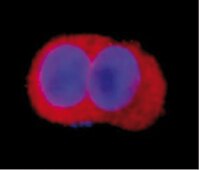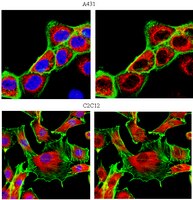AMPA Receptor-mTOR Activation is Required for the Antidepressant-Like Effects of Sarcosine during the Forced Swim Test in Rats: Insertion of AMPA Receptor may Play a Role.
Chen, KT; Tsai, MH; Wu, CH; Jou, MJ; Wei, IH; Huang, CC
Frontiers in behavioral neuroscience
9
162
2015
Mostrar resumen
Sarcosine, an endogenous amino acid, is a competitive inhibitor of the type I glycine transporter and an N-methyl-d-aspartate receptor (NMDAR) coagonist. Recently, we found that sarcosine, an NMDAR enhancer, can improve depression-related behaviors in rodents and humans. This result differs from previous studies, which have reported antidepressant effects of NMDAR antagonists. The mechanisms underlying the therapeutic response of sarcosine remain unknown. This study examines the role of mammalian target of rapamycin (mTOR) signaling and α-amino-3-hydroxy-5-methylisoxazole-4-propionate receptor (AMPAR) activation, which are involved in the antidepressant-like effects of several glutamatergic system modulators. The effects of sarcosine in a forced swim test (FST) and the expression levels of phosphorylated mTOR signaling proteins were examined in the absence or presence of mTOR and AMPAR inhibitors. In addition, the influence of sarcosine on AMPAR trafficking was determined by analyzing the phosphorylation of AMPAR subunit GluR1 at the PKA site (often considered an indicator for GluR1 membrane insertion in neurons). A single injection of sarcosine exhibited antidepressant-like effects in rats in the FST and rapidly activated the mTOR signaling pathway, which were significantly blocked by mTOR inhibitor rapamycin or the AMPAR inhibitor 2,3-dihydroxy-6-nitro-7-sulfamoyl-benzo(f)quinoxaline (NBQX) pretreatment. Moreover, NBQX pretreatment eliminated the ability of sarcosine to stimulate the phosphorylated mTOR signaling proteins. Furthermore, GluR1 phosphorylation at its PKA site was significantly increased after an acute in vivo sarcosine treatment. The results demonstrated that sarcosine exerts antidepressant-like effects by enhancing AMPAR-mTOR signaling pathway activity and facilitating AMPAR membrane insertion. Highlights-A single injection of sarcosine rapidly exerted antidepressant-like effects with a concomitant increase in the activation of the mammalian target of rapamycin mTOR signaling pathway.-The antidepressant-like effects of sarcosine occur through the activated AMPAR-mTOR signaling pathway.-Sarcosine could enhance AMPAR membrane insertion via an AMPAR throughput. | 26150775
 |
Pdx-1 activates islet α- and β-cell proliferation via a mechanism regulated by transient receptor potential cation channels 3 and 6 and extracellular signal-regulated kinases 1 and 2.
Hayes, HL; Moss, LG; Schisler, JC; Haldeman, JM; Zhang, Z; Rosenberg, PB; Newgard, CB; Hohmeier, HE
Molecular and cellular biology
33
4017-29
2013
Mostrar resumen
The homeodomain transcription factor Pdx-1 has important roles in pancreatic development and β-cell function and survival. In the present study, we demonstrate that adenovirus-mediated overexpression of Pdx-1 in rat or human islets also stimulates cell replication. Moreover, cooverexpression of Pdx-1 with another homeodomain transcription factor, Nkx6.1, has an additive effect on proliferation compared to either factor alone, implying discrete activating mechanisms. Consistent with this, Nkx6.1 stimulates mainly β-cell proliferation, whereas Pdx-1 stimulates both α- and β-cell proliferation. Furthermore, cyclins D1/D2 are upregulated by Pdx-1 but not by Nkx6.1, and inhibition of cdk4 blocks Pdx-1-stimulated but not Nkx6.1-stimulated islet cell proliferation. Genes regulated by Pdx-1 but not Nkx6.1 were identified by microarray analysis. Two members of the transient receptor potential cation (TRPC) channel family, TRPC3 and TRPC6, are upregulated by Pdx-1 overexpression, and small interfering RNA (siRNA)-mediated knockdown of TRPC3/6 or TRPC6 alone inhibits Pdx-1-induced but not Nkx6.1-induced islet cell proliferation. Pdx-1 also stimulates extracellular signal-regulated kinase 1 and 2 (ERK1/2) phosphorylation, an effect partially blocked by knockdown of TRPC3/6, and blockade of ERK1/2 activation with a MEK1/2 inhibitor partially impairs Pdx-1-stimulated proliferation. These studies define a pathway by which overexpression of Pdx-1 activates islet cell proliferation that is distinct from and additive to a pathway activated by Nkx6.1. | 23938296
 |
N-acetylcysteine protects against apoptosis through modulation of group I metabotropic glutamate receptor activity.
Sun, L; Gu, L; Wang, S; Yuan, J; Yang, H; Zhu, J; Zhang, H
PloS one
7
e32503
2011
Mostrar resumen
The activation of group I metabotropic glutamate receptor (group I mGlus) has been shown to produce neuroprotective or neurotoxic effects. In this study, we investigated the effects of N-acetylcysteine (NAC), a precursor of the antioxidant glutathione, on group I mGlus activation in apoptosis of glial C6 and MN9D cell lines, and a rat model of Parkinson's disease (PD). We demonstrated that NAC protected against apoptosis through modulation of group I mGlus activity. In glial C6 cells, NAC promoted phosphorylation of ERK induced by (s)-3,5-dihydroxy-phenylglycine (DHPG), an agonist of group I mGlus. NAC enhanced the group I mGlus-mediated protection from staurosporine (STS)-induced apoptosis following DHPG treatment. Moreover, in rotenone-treated MN9D cells and PD rat model, NAC protected against group I mGlus-induced toxicity by compromising the decrease in phosphorylation of ERK, phosphorylation or expression level of TH. Furthermore, the results showed that NAC prohibited the level of ROS and oxidation of cellular GSH/GSSG (E(h)) accompanied by activated group I mGlus in the experimental models. Our results suggest that NAC might act as a regulator of group I mGlus-mediated activities in both neuroprotection and neurotoxicity via reducing the oxidative stress, eventually to protect cell survival. The study also suggests that NAC might be a potential therapeutics targeting for group I mGlus activation in the treatment of PD. | 22442667
 |












